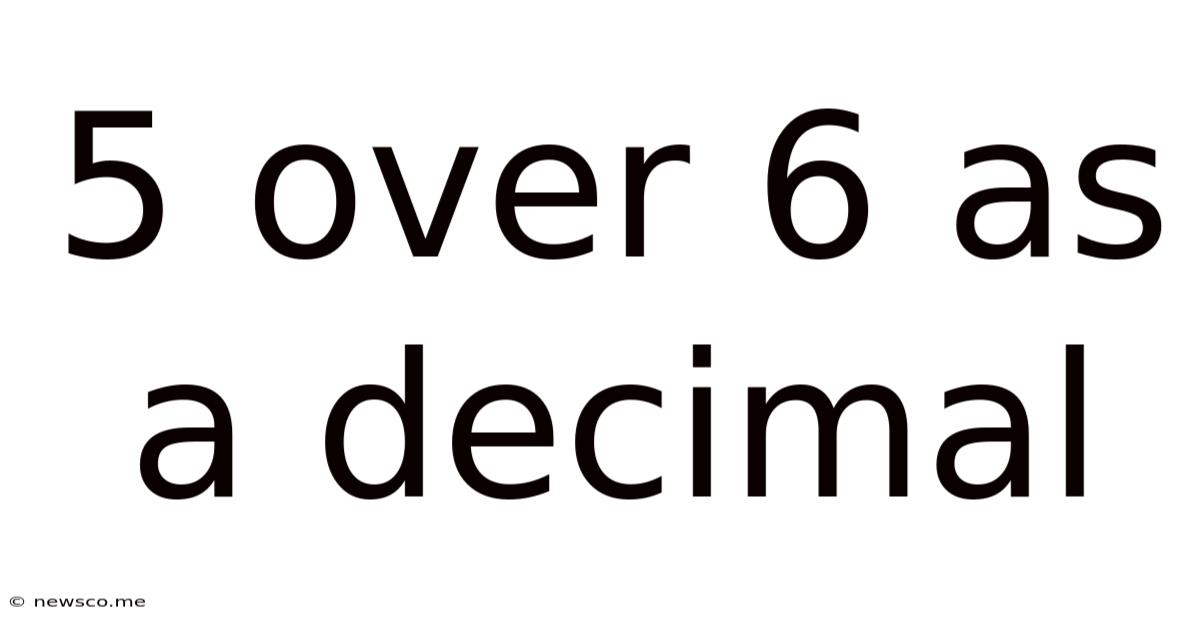5 Over 6 As A Decimal
News Co
Mar 23, 2025 · 5 min read

Table of Contents
5 Over 6 as a Decimal: A Comprehensive Guide
Converting fractions to decimals is a fundamental skill in mathematics, crucial for various applications from everyday calculations to advanced scientific computations. This comprehensive guide delves into the conversion of the fraction 5/6 into its decimal equivalent, exploring different methods and highlighting the significance of understanding this process. We'll also explore related concepts and practical applications to solidify your understanding.
Understanding Fractions and Decimals
Before diving into the conversion, let's refresh our understanding of fractions and decimals. A fraction represents a part of a whole, expressed as a ratio of two integers: the numerator (top number) and the denominator (bottom number). A decimal represents a number in base-10, using a decimal point to separate the whole number part from the fractional part.
The fraction 5/6 signifies five parts out of a total of six equal parts. Our goal is to express this same proportion using a decimal representation.
Method 1: Long Division
The most straightforward method to convert a fraction to a decimal is through long division. We divide the numerator (5) by the denominator (6):
0.8333...
6 | 5.0000
4.8
---
0.20
0.18
---
0.020
0.018
---
0.0020
0.0018
---
0.0002
As you can see, the division process continues indefinitely, yielding a repeating decimal. The digit '3' repeats infinitely. This is denoted by placing a bar over the repeating digit(s): 0.83̅
Method 2: Using Equivalent Fractions
Another approach involves creating an equivalent fraction with a denominator that is a power of 10 (10, 100, 1000, etc.). This method is particularly useful when the denominator has factors that can easily be manipulated to reach a power of 10. Unfortunately, 6 doesn't have factors that directly lead to a power of 10 (its prime factorization is 2 x 3). Therefore, this method isn't directly applicable for 5/6 without resorting to approximations or long division. However, understanding this method is beneficial for fractions with denominators like 2, 4, 5, 8, 10, etc.
For example, converting 1/4 to a decimal:
1/4 can be converted to 25/100 by multiplying both the numerator and denominator by 25. This gives us 0.25.
Method 3: Using a Calculator
The simplest method, particularly for more complex fractions, is to use a calculator. Simply enter 5 ÷ 6 and the calculator will display the decimal equivalent: 0.833333... (or a truncated version depending on the calculator's display).
Understanding Repeating Decimals
The decimal representation of 5/6, 0.83̅, is a repeating decimal or recurring decimal. This means the sequence of digits repeats infinitely. It's crucial to understand this characteristic, as rounding off can lead to inaccuracies in calculations, especially in scientific or engineering contexts.
Representing Repeating Decimals
There are several ways to represent repeating decimals to indicate that the digits continue indefinitely:
- Bar Notation: This is the most common method, placing a bar above the repeating digits: 0.83̅
- Ellipsis: Using three dots (...) to indicate that the pattern continues: 0.8333...
- Parentheses: Using parentheses to enclose the repeating block: 0.8(3)
Always choose a method that clearly conveys the repeating nature of the decimal.
Practical Applications of Decimal Conversions
Converting fractions to decimals is essential in many practical scenarios:
- Financial Calculations: Calculating percentages, interest rates, and proportions in financial contexts often require decimal representations.
- Engineering and Science: Precise measurements and calculations in engineering and scientific fields rely heavily on decimal accuracy. Working with fractions and converting them to decimals is fundamental.
- Everyday Calculations: From splitting bills equally to calculating discounts, converting fractions to decimals can simplify daily calculations.
- Computer Programming: Many programming languages and algorithms work primarily with decimal representations of numbers.
- Data Analysis and Statistics: Representing and analyzing data often involves converting fractions to decimals for efficient computations and interpretations.
Approximations and Rounding
While the exact decimal representation of 5/6 is 0.83̅, in some situations, approximations and rounding are necessary. The level of precision required depends entirely on the context.
- Rounding to one decimal place: 0.8
- Rounding to two decimal places: 0.83
- Rounding to three decimal places: 0.833
It's important to note that rounding introduces a degree of error, and the choice of precision must be made carefully considering the potential impact on the outcome of calculations.
Further Exploration: Converting other Fractions
The methods discussed above can be applied to convert other fractions to decimals. The complexity of the process depends largely on the denominator of the fraction. Fractions with denominators that are powers of 10 are easiest to convert. Others may result in terminating decimals or repeating decimals, and long division often becomes necessary for exact conversions.
Consider these examples:
- 1/2 = 0.5 (Terminating decimal)
- 1/3 = 0.3̅ (Repeating decimal)
- 7/8 = 0.875 (Terminating decimal)
- 2/9 = 0.2̅ (Repeating decimal)
Conclusion
Converting the fraction 5/6 to its decimal equivalent, 0.83̅, highlights the importance of understanding different conversion methods. Whether using long division, exploring equivalent fractions (though less effective in this specific case), or employing a calculator, the process reveals the fundamental relationship between fractions and decimals. The concept of repeating decimals and appropriate rounding techniques are also crucial aspects to consider when working with these representations. Mastering these techniques is vital for various mathematical and practical applications, from everyday calculations to complex scientific endeavors. The ability to accurately convert fractions to decimals is a cornerstone of numeracy and essential for success in many fields.
Latest Posts
Related Post
Thank you for visiting our website which covers about 5 Over 6 As A Decimal . We hope the information provided has been useful to you. Feel free to contact us if you have any questions or need further assistance. See you next time and don't miss to bookmark.